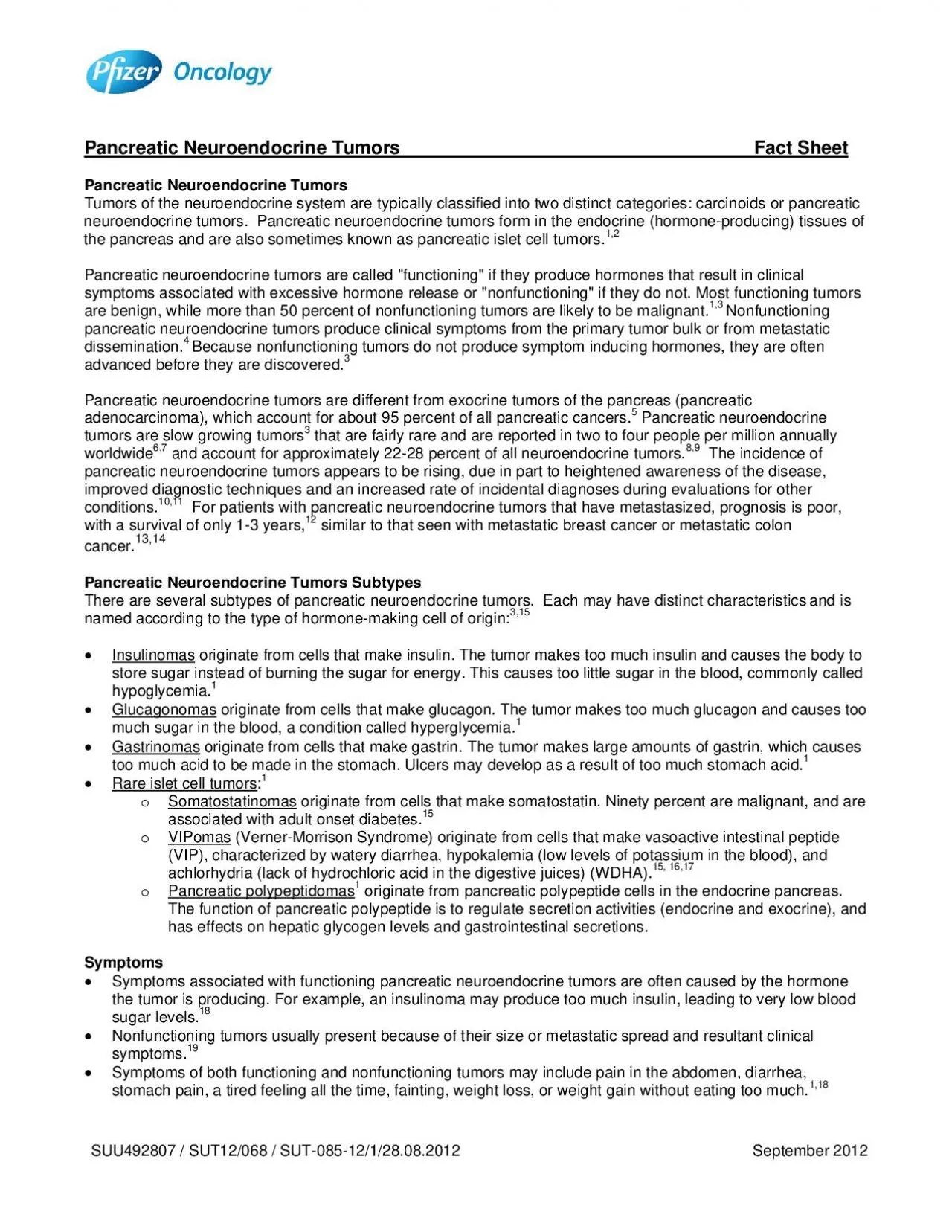

Fact Sheet Pancreatic Neuroendocrine Tumors Tumors of the neuroendocrine system are typically classified into two distinct categories carcinoids or pancreatic neuroendocrin ID: 938880
Download Pdf The PPT/PDF document "SUU492807 SUT12068 SUT08512128082012 S..." is the property of its rightful owner. Permission is granted to download and print the materials on this web site for personal, non-commercial use only, and to display it on your personal computer provided you do not modify the materials and that you retain all copyright notices contained in the materials. By downloading content from our website, you accept the terms of this agreement.
SUU492807 / SUT12/068 / SUT-085-12/1/28.08.2012 September 2012 Fact Sheet Pancreatic Neuroendocrine Tumors Tumors of the neuroendocrine system are typically classified into two distinct categories: carcinoids or pancreatic neuroendocrine tumors. Pancreatic neuroendocrine tumors form in the endocrine (hormone-producing) tissues of the pancreas and are also sometimes known as pancreatic islet cell tumors. store sugar instead of burning the sugar for energy. This causes too little sugar in the blood, commonly called hypoglycemia. Glucagonomas originate from cells that make glucagon. The tumor makes too much glucagon and causes too much sugar in the blood, a condition called hyperglycemia. Gastrinomas originate from cells that make gastrin. too much acid to be made in the stomach. Ulcers may develop as a result of too much stomach acid. Rare islet cell tumors: Somatostatinomas originate from cells that make somatostatin. Ninety percent are malignant, and are associated with adult onset diabetes. VIPomas (Verner-Morrison Syndrome) originate from cells that make vasoactive intestinal peptide (VIP), characterized by watery di The function of pancreatic polypeptide is to regulate secretion activities (endocrine and exocrine), and has effects on hepatic glycogen levels and gastrointestinal secretions. Symptoms Symptoms associated with functioning pancreatic neuroendocrine tumors are often caused by the hormone SUU492807 / SUT12/068 / SUT-085-12/1/28.08.2012 September 2012 Diagnosis If symptoms exist, blood and urine tests are used to determine if the amounts of hormones in the body are normal. Other tests may include x-rays and special scans.Treatment Current treatment options for pancreatic neuroendocrine tumors are limited: Surgery is the most common treatment The doctor may take out the tumor and most or part of the pancreas. Sometimes the stomach is partially removed (gastrectomy) because of ulcers. Lymph nodes in the area may also be removed. Combination chemotherapy mare completely) as well as increased survival in selected patients. Hormone therapy uses hormones (somatostatin analogues) to relieve symptoms caused by the tumor by blocking activity of hormon
es. Hepatic arterial occlusion or embolization uses drugs or other agents to reduce or block the flow of blood to parts of the liver in order to specifically deliver local chemotherapy to treat metastases in the liver. It is common for pancreatic neuroendocrine tumors to metastasize to the liver. With the exception of pain relief from bone metastases, radiation therapy has a limited role in this disease. Two targeted therapies are approved for the treatment of advanced pancreatic NETpotential to change the treatment paradigm for the diited therapeutic options.#### SUU492807 / SUT12/068 / SUT-085-12/1/28.08.2012 September 2012 National Cancer Institute. Islet Cell Tumors (Endocrine Pancreas) Treatment Patient Version. Available at: http://www.cancer.gov/cancertopics/pdq/treatment/isletcell/patient/allpages. Accessed Aug. 8, 2012. National Cancer Institute. Carcinoid. Available at: http://www.cancer.gov/dictionary/?CdrID=44233. Accessed Aug. 8, 2012. University of Southern California. Islet Cell Tumors of the Pancreas. Available at: http://www.surgery.usc.edu/divisions/tumor/pancreasdiseases/web%20pages/Endocrine%20tumors/pancreatic%2 0tumors/islet%20cell%20tumors.html. Accessed Aug. 8, 2012. National Cancer Institute. Islet Cell Tumors (Endocrine Pancreas) Treatment Health Professional Version. Available at: http://www.cancer.gov/cancertopics/pdq/treatment/isletcell/healthprofessional/allpages. Accessed March 1, 2011. National Cancer Institute. General Information About Pancreatic Cancer. Available at: http://www.cancer.gov/cancertopics/pdq/treatment/pancreatic/Patient/page1. Accessed Aug. 8, 2012. Ramage JK, Davies AHG, Ardill et al. Guidelines for the management of(including carcinoid) tumours. Gut. 2005;54:iv116 Halfdanarson TR, Rabe KG, Rubin J et al. Pancreatic neuroendocrine tumors (PNETs): incidence, prognosis and recent trend toward improved survival. Ann Oncol. 2008;19:172733 Pape UF, Berndt U, Muller-Nordhorn J et al. Prognostic factors for long-term outcome in gastroenteropancreatic neuroendocrine tumors. Endocrine-Related Cancers; 15: 1083-97, 2008. Ter-Minassian M, Frauenhoffer CS, Hooshmand SM et al. Prospective analysis of clinical outcomes and prog
nostic factors in patients with Neuroendocrine tumors (NETs). ASCO Meeting Abstracts; Jun 14; 4044, 2010. Cheema A, et al. Incidental diagnosis of pancreatic Neuroendocrine tumors. ASCO GI 2011; Abstract 190. Oberg K. Gastrointestinal Neuroendocrine tumors. Annals of Oncology. 21(S7); vii72-vii80, 2010. Yao JC, et al. Population-based study of islet cell carcinoma. Ann Surg Oncol. 2007;14(12):34923500 Pal SK, et al "Lack of survival benefit in metastatic breast cancer with newer chemotherapy agents: The City of Hope cancer experience" 2008; Abstract 95. rvival in Metastatic Colorectal Cancer is Associated With Adoption of Hepatic Resection and Improved Chemotherapy. J Clin Oncol. 2009; 7:3677-3683. Johns Hopkins University - The Sol Goldman Pancreatic Cancer Research Center. Islet Cell Tumors of the Pancreas/Endocrine Neoplasms of the Pancreas. Available at: http://pathology.jhu.edu/pancreas/TreatmentEndocrine.php?area=tr. Accessed Aug. 8, 2012. MedlinePlus Medical Encyclopedia. Hypokalemia. Available at: http://www.nlm.nih.gov/medlineplus/ency/article/000479.htm. Accessed Aug. 8, 2012. National Cancer Institute. Achlorhydria. Available at:http://www.cancer.gov/dictionary?cdrid=46213. Accessed Aug. 8, 2012. MedlinePlus Medical Encyclopedia. Pancreatic islet cell tumor. Available at: http://www.nlm.nih.gov/medlineplus/ency/article/000393.htm. Accessed Aug. 8, 2012. Medscape (Anand MKN and Cowie AG). Pancreas, Islet Cell Tumors. Available at: http://emedicine.medscape.com/article/36965ation. Pfizer Inc. AFINITOR (everolimus) Prescribing Information. Novartis Pharmaceuticals. U.S. Food and Drug Administration. Drugs@FDA: Zanosar. Available at: http://www.accessdata.fda.gov/scripts/cder/drugsatfda/index.cfm?fuseaction=Search.Label_ApprovalHistory#app . Accessed Aug. 8, 2012. ZANOSAR (streptozocin sterile powder) Prescribing Information. Teva Parenteral Medicines, Inc. U.S. Food and Drug Administration. Drugs@FDA: SANDOSTATIN LAR. Available at: http://www.accessdata.fda.gov/scripts/cder/drugsatfda/index.cfm?fuseaction=Search.Label_ApprovalHistory#app . Accessed Aug. 8, 2012. SANDOSTATIN LAR (octreotide acetate) Prescribing Information. Novartis Pharmaceuticals